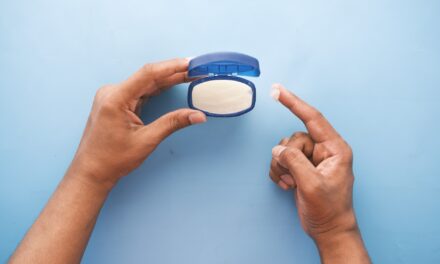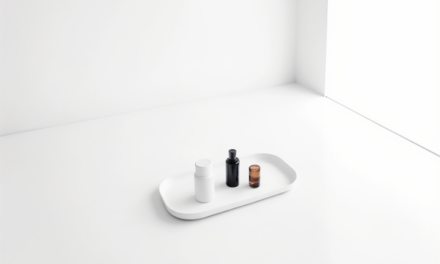Azelaic Acid: How It Works and Why You Might Need It In Your Skincare
Azelaic acid may not be the most hyped skincare ingredient, but, frankly speaking, it deserves way more recognition. Despite its underappreciated status, azelaic acid boasts a myriad of evidence-backed benefits, including combating acne, mitigating rosacea, addressing hyperpigmentation, and fighting against free radicals.

What is azelaic acid?
Azelaic acid is a type of dicarboxylic acid. In simpler terms, it’s an acid that has two carboxyl groups. Don’t worry if this sounds a bit scientific – it is present in our skin naturally. It is produced by a yeast that lives on healthy human skin.
It is also found in grains such as wheat, rye, and barley. Today, for use in cosmetics and medicine, this ingredient is mainly produced in a chemical process that breaks down a type of oil (oleic acid) with the help of ozone.
Azelaic acid boasts a variety of skin benefits. It reduces inflammation, combats harmful microbes, acts as an antioxidant, prevents blocked pores, and has shown potential in cancer treatment. The United States Food and Drug Administration endorses azelaic acid for treating mild to moderate acne and rosacea, a condition that causes redness and often pimples on the face.
Azelaic acid also effectively treats skin discoloration issues like hyperpigmentation and melasma, and it helps with alopecia, a type of hair loss. Scientific research underscores its biological activities, drug delivery effectiveness, and mechanisms of action. It’s particularly beneficial for acne management. Azelaic acid reduces excess oil in pores, soothes inflammation, slows down rapid skin cell production, and fights the acne-triggering bacteria.
What can azelaic acid do for your skin?
1. Fighting Inflammation
One of the key actions of azelaic acid is its ability to calm inflammation. This is crucial because inflammation is a core problem in conditions like acne and rosacea. It scavenges free radicals and reduces the production of pro-inflammatory substances in cells (mitochondrial oxidoreductases). This action is crucial in reducing the redness, swelling, and discomfort associated with conditions like acne and rosacea.
2. Battling Bacteria
Acne often flares up due to certain bacteria (like Cutibacterium acnes) thriving in our skin’s pores. Azelaic acid steps in as a bacteria-buster, inhibiting the growth of these unwanted guests. By inhibiting the synthesis of proteins essential for bacterial survival, azelaic acid reduces bacterial growth in the follicles, preventing and treating acne breakouts.
3. Exfoliating and Unclogging Pores
Azelaic acid is a gentle exfoliant. In scientific terms, it has keratolytic and comedolytic effects. What does this mean? Essentially, it helps normalize the disordered growth of skin cells lining the follicles – a common issue in acne-prone skin. By inhibiting the proliferation and differentiation of keratinocytes (cells that make up a significant portion of the outer skin layer), it prevents the formation of comedones (clogged pores) and promotes the shedding of dead skin cells. This action keeps the pores clear and reduces acne lesions.
4. All-around acne treatment
Clinical trials have substantiated azelaic acid’s role in decreasing acne severity. By tackling acne from multiple angles – reducing inflammation, fighting bacteria, and keeping pores clear – it is a multi-tasking remedy for those battling with acne.
5. A Safe Option for Hyperpigmentation
Azelaic acid is not just effective but also safe for treating various forms of hyperpigmentation. Studies have shown its efficacy in dealing with melasma and post-inflammatory hyperpigmentation. It works well for people with naturally dark skin tone. Azelaic acid inhibits tyrosinase, an enzyme crucial for melanin production. Melanin is the pigment that gives skin its color, and overproduction can lead to dark spots. By regulating melanin production, azelaic acid helps in evening out skin tone and reducing the appearance of hyperpigmentation.
Azelaic acid safety and use in pregnancy & breastfeeding
Generally, azelaic acid is safe and rarely causes severe side effects, even when used in high concentrations (10-20%). In rare cases, though, it can cause skin irritation.
Azelaic acid can be irritating to eyes and other mucous membranes, apply it carefully around the eyes and avoid lips.
In terms of pregnancy safety, the FDA classifies topical products with 15%-20% azelaic acid as a “Category B” drug. This means that, although it hasn’t been thoroughly tested in pregnant or breastfeeding humans, it hasn’t shown any harm to fetuses in animal studies. So while it doesn’t guarantee absolute safety during pregnancy, it’s generally considered safe to use.
Can azelaic acid cause sun sensitivity?
Because of its chemical properties, azelaic acid is unlikely to cause sun sensitivity (or a photoirritative or photosensitive reaction). Still, some people have reported sun sensitivity when using topical medications (creams, gels) with azelaic acid. It’s possible that these reactions were caused by other ingredients in these products.
While it’s unlikely that azelaic acid will increase your skin’s sun sensitivity, it’s still wise to be careful about sun exposure when using this ingredient. This is especially true if you’re using azelaic acid to tackle hyperpigmentation and/or acne, blackheads, and clogged pores. The sun can make these conditions worse, so limiting UV exposure as much as possible is crucial. Using a broad-spectrum sunscreen with high SPF, avoiding direct sun, and wearing sun-protective clothing is highly recommended when you’re using azelaic acid.
If you want to be extra cautious, consider using products with azelaic acid at night. This isn’t strictly necessary, especially if you’re not spending your day in direct sunlight, but some people prefer it because the texture of products with azelaic acid doesn’t always play well with sunscreens and makeup.
Effective concentration
Azelaic acid used in dermatology comes in concentrations ranging from 10% to 20%. The majority of clinical studies have explored the use of azelaic acid at a 15% concentration, with a 20% concentration often reserved for treating hyperpigmentation resulting from acne.
However, most over-the-counter or cosmeceutical skincare products contain a 10% concentration of azelaic acid, with some available at 15%. These lower concentrations can be an excellent starting point if you’re new to this active ingredient and want to see how your skin reacts.
How long does azelaic acid take to work?
- Acne: Visible results can often be seen within a few weeks, typically around 4 to 6 weeks of consistent use. However, significant improvement often takes longer, with optimal results generally seen after about 12 weeks (or 3 months) of regular use.
- Hyperpigmentation and melasma: Treating hyperpigmentation and melasma often requires a more extended period. You may start to see some initial improvements in skin discoloration within 4 weeks. However, significant lightening of dark spots typically occurs after about 12 to 24 weeks (or 3 to 6 months) of consistent use.
- Rosacea: Improvement in rosacea symptoms can usually be seen within a few weeks. In clinical studies, azelaic acid has been shown to significantly reduce rosacea symptoms over a period of 12 to 15 weeks.
Why isn’t azelaic acid more popular in skincare?
Despite the extensive research and proven success of azelaic acid in skincare, it’s surprising to see relatively few products containing it on the market. The primary challenge with azelaic acid lies in its poor solubility and difficulty penetrating the skin. To be effective, it requires a high concentration, typically between 15% to 20%. Achieving such potency makes it harder for skincare formulators to produce products with pleasant textures.
Moreover, traditionally, big skincare names have been reluctant to incorporate such high concentrations of any ingredient into their products. This trend is changing with the emergence of newer brands like The Ordinary, which are embracing high-concentration formulas. However, for the majority of mainstream mass cosmetic brands, venturing out of their comfort zone in this way feels a bit like wearing stripes with plaid—it’s just not done.
New cool cousins of azelaic acid
Potassium azeloyl diglycinate
Potassium azeloyl diglycinate is a derivative of azelaic acid. It is made by blending azelaic acid’s chloride with glycine (an amino acid) and potassium hydroxide. Though not as well-studied as azelaic acid, existing research does hint at its potential. It might reduce skin redness, dark spots, and blemishes effectively too.
Some even suggest that it’s more bio-available and potent than azelaic acid, but without a comparative study, we can’t be sure.
One of the big pluses of potassium azeloyl diglycinate is that it dissolves in water much better than azelaic acid. This means skincare products containing it can feel smoother and nicer when you apply them to your skin.
Azelaic acid-loaded solid lipid nanoparticles
A promising new development: scientists have enhanced the skin absorption of azelaic acid. They achieved this feat by encapsulating azelaic acid in solid lipid nanoparticles, a technique that boosts its effectiveness at lower concentrations, potentially between 5% and 10%. However, there’s a catch. This advanced form of azelaic acid comes with a higher price tag, leading brands to incorporate it into their products at minimal concentrations of just 1-2%. Unfortunately, these levels fall short of the efficacy threshold, somewhat dampening the excitement around this innovation.
Azelaic acid against acne
Azelaic acid works against acne because of its antibacterial and anti-inflammatory properties. It can inhibit bacterial protein synthesis and cellular metabolism, which essentially means it can prevent the acne-triggering bacteria from growing and spreading. Not only that, but azelaic acid also helps to modulate follicular hyperproliferation and inflammation in skin, or in simpler terms, it helps regulate the overproduction and clumping of skin cells in the hair follicles that can lead to clogged pores and acne.
Now, let’s talk about how to incorporate azelaic acid into your skincare routine. The recommended concentration for treating acne is typically 15%, which is generally less irritating than higher concentrations like 20% . Most research suggests applying azelaic acid twice daily, but as always, you should start slow and observe your skin’s response before increasing usage.
According to the 2016 European evidence-based guidelines, azelaic acid can be used for mild-to-moderate papulopustular acne either alone or in combination with other treatments. It’s also recommended for maintenance therapy, which means it can help keep your acne under control long-term.
In clinical trials, azelaic acid has shown promising results for acne treatment. One of the largest randomized controlled trials (RCTs) found that 20% azelaic acid cream used twice daily was slightly less effective than benzoyl peroxide 3% in combination with clindamycin 1% used once daily. However, it was observed that azelaic acid was more effective than a placebo, particularly in addressing the inflammatory aspects of acne.
Further, azelaic acid was found to improve the Dermatology Life Quality Index (DLQI), a measure of the impact of skin diseases on the quality of life, and reduce the severity of post-inflammatory hyperpigmentation, which are the dark marks that remain on the skin after an acne breakout has cleared.
However, it’s important to note that in rare cases azelaic acid can lead to skin irritation and dryness. These are most likely due to the twice-daily application, and these side effects might be lessened if the application is reduced to once a day.
If you are fighting acne, it is best to include azelaic acid in your routine alongside other anti-acne actives for example retinoids, niacinamide and salicylic acid.
Azelaic acid for reducing oiliness
Azelaic acid stands out as one of the few skincare ingredients with a proven ability to reduce skin oiliness. In a study with 27 women aged 19 to 25, participants underwent six treatments with a 20% azelaic acid solution applied to their faces. The outcomes showed a decrease in sebum levels following the treatments.
Even more remarkable, this reduction in sebum production was sustained three months post-treatment. In addition to the decreased oiliness, the study also recorded significant improvements in both the number and severity of acne lesions.
Azelaic acid against pigmentation and for managing melasma
Azelaic acid is one skincare active that has been shown to help manage melasma and can also be used to fade other pigmentation spots and prevent uneven skin tone. Azelaic acid acts by inhibiting certain cellular activities in melanocytes, the cells responsible for pigment production in our skin. This is done through inhibiting tyrosinase, a key enzyme in the pigment production process. Azelaic acid also has an antioxidant effect, which can aid in lightening the skin by reducing free radicals.
Numerous Randomized Controlled Trials (RCTs) and open-label clinical trials have examined the use of azelaic acid in managing melasma and hyperpigmentation. It was found that a 20% concentration of azelaic acid cream showed good or excellent results in lightening melasma spots in multiple studies. In one study, 73% of the patients treated with azelaic acid showed good to excellent results in terms of reduced melasma pigment intensity and lesion size. It’s worth noting that initial mild to moderate skin irritation, such as burning, itching, stinging, dryness, and erythema, might occur at the beginning of the treatment, but these reactions tend to be temporary and minor.
Interestingly, some studies found that combining azelaic acid with other active ingredients could further enhance its pigmentation-reducing effects. For example, a formulation containing azelaic acid 20% plus mandelic acid 10%, phytic acid 5%, 4N-butyl resorcinol 5%, and ferulic acid 5% was found to be very effective in reducing pigmentation.
There are also studies that confirm safety and efficacy of azelaic acid for reducing hyperpigmentation in darker skin tones.
So how often should you use azelaic acid, and what concentration should you look for? While the studies suggest a 20% azelaic acid cream can be beneficial, it’s always recommended to start with a lower concentration to test your skin’s tolerance. You can gradually increase the concentration if no adverse reactions occur. Most studies applied azelaic acid once or twice a day, but remember to always follow the instructions on the product label or your dermatologist’s advice.
In summary, azelaic acid shows promising results for treating hyperpigmentation and melasma, offering an effective solution to fade dark spots and prevent uneven skin tone.
Azelaic acid for rosacea-prone skin
Rosacea is a common skin condition that often leads to redness and visible blood vessels on the face. Scientific studies have shown that people with rosacea have higher levels of certain proteins, like serine protease kallikrein-5 (KLK5) and the antimicrobial peptide cathelicidin (CAMP), which can cause inflammation, abnormal growth of blood vessels, and other rosacea symptoms (3).
Here’s the good news: azelaic acid, a natural plant-based ingredient, can help. Researchers have found that applying azelaic acid to skin cells significantly decreases levels of KLK5 and total protease activity, which are associated with inflammation. What this means in everyday language is that azelaic acid can help to calm down the overactive proteins that contribute to rosacea symptoms.
Several clinical trials have shown promising results for azelaic acid in the treatment of rosacea. In fact, the Food and Drug Administration (FDA) has approved 15% topical azelaic acid for the treatment of inflammatory papules and pustules of rosacea, a specific type of rosacea characterized by breakouts of red bumps and pus-filled bumps.
If you’re considering integrating azelaic acid into your skincare routine, you might be asking: how do I use it? A 15% concentration is typically recommended for rosacea-prone skin, and most research studies applied this twice daily. According to one study we found, once per day application can be also effective.
In clinical trials, azelaic acid has consistently shown positive results. In one large study, patients with rosacea applied a 15% azelaic acid foam twice daily for 12 weeks. At the end of the study, 32% of the patients showed a significant improvement in their rosacea symptoms compared to 23.5% in the control group, which was given a vehicle treatment with no active ingredients.
Another study measured patients’ quality of life and found it improved with azelaic acid treatment, with 57.2% reporting excellent or good improvement scores compared to 44.7% in the control group. However, some patients reported slight irritation after applying the azelaic acid. This is a relatively common side effect and usually results in minor transient stinging, burning, or itching sensation.
Further studies found azelaic acid to be more effective than metronidazole, another common rosacea treatment, in reducing the number of lesions and redness. Interestingly, the effectiveness of metronidazole seemed to plateau after some time, whereas azelaic acid continued to produce improvements even after 15 weeks of use.
Overall, the high level of evidence supports current guidelines for using azelaic acid to treat rosacea, especially for reducing inflammatory lesions.
Practical summary: How to include azelaic acid in your skincare routine
- Effective concentration: azelaic acid in dermatology is used in concentrations ranging from 10% to 20%. Start with a lower concentration to test your skin’s tolerance and gradually increase the concentration if no adverse reactions occur.
- Application: the majority of clinical studies suggest applying azelaic acid twice daily. However, to minimize potential skin irritation and dryness, especially for beginners, it’s advised to start with once daily application.
- Sun protection: although azelaic acid is unlikely to cause sun sensitivity, you need a daily broad spectrum sunscreen when using it.
- Combining azelaic acid with other skincare actives: Azelaic acid is a great team player and works well in a routine together with niacinamide, retinoids, salicylic acid and vitamin C (ascorbic acid). If you are using benzoyl peroxide, use it in a different skincare step than azelaic acid – for example, benzoyl peroxide in the morning and azelaic acid at night.
- Use in pregnancy: Azelaic acid is generally considered safe to use during pregnancy and breastfeeding.
Choose your products based on actives
WIMJ Search allows you to select skincare products based on what’s inside. Filter products by actives included, and exclude ingredients you don’t want. Check the concentration of ingredients and potential irritants.
Sources
- Azelaic Acid: Evidence-based Update on Mechanism of Action and Clinical Application https://europepmc.org/article/med/26355614
- Long-term effect of azelaic acid peel on sebum production in acne https://onlinelibrary.wiley.com/doi/abs/10.1111/dth.15186
- The versatility of azelaic acid in dermatology https://www.tandfonline.com/doi/abs/10.1080/09546634.2020.1800579
- Combination azelaic acid therapy for acne vulgaris https://www.sciencedirect.com/science/article/abs/pii/S0190962200372590
- Preparation and Evaluation of Azelaic Acid Topical Microemulsion Formulation: In Vitro and In Vivo Study https://www.ncbi.nlm.nih.gov/pmc/articles/PMC8003802/
-
Experience of applying azelaic acid in dermatology https://vestnikdv.ru/jour/article/view/251/252
-
Drug-Induced Photosensitivity https://journals.sagepub.com/doi/abs/10.1310/hpj4102-196
-
Azelaic Acid: Properties and Mode of Action https://www.karger.com/Article/Abstract/354888
Related Articles
Winter Skin Care: Navigating the Chilly Season with Healthy Skin
Let’s dive into understanding winter skin and how to best care for it.
Why Has My Skin Become Sensitive All of a Sudden?
Have you recently noticed your skin turning into a battleground of reactions? Is your once-placid complexion now flaring up at your go-to beauty products? You’re not alone. Suddenly sensitive skin can perplex anyone. Here’s a breakdown of why it might be happening and what you can do about it.
Sunflower Seed Oil: The Top Face Oil For Skin Barrier
Struggling to decide which face oil to choose? Sunflower seed oil might not be the most glamorous or exotic of skincare oils, but it could actually be the best for your skin.
Does Bakuchiol Help With Acne?
Discover how Bakuchiol, a plant alternative to retinol, can help combat acne. Dive into the latest research findings, learn the effective concentration and application tips, and uncover why Bakuchiol might be your new go-to for clear, happy skin.
CBD Skincare Benefits and Unknowns
Discover the impressive potential of CBD in skincare and learn about the risks. Our evidence-based exploration covers the CBD potential for treating acne, eczema, psoriasis and combating inflammation.
Thiamidol
Dive into our comprehensive guide to thiamidol, an effective tyrosinase inhibitor with impressive results against hyperpigmentation. Explore its science, evidence, and how to incorporate it into your skincare routine.
Is Petrolatum In Skincare Bad?
Get the facts about petrolatum, a top ingredient in skincare. Learn how this powerful moisturizer soothes, protects, and hydrates the skin. Plus, discover why it’s trending on social media and how it’s safe even for the most sensitive skin areas.
Can You Use Retinoids for Rosacea-Prone Skin?
If you’ve been grappling with the frustrating skin condition called rosacea, you may have been advised to steer clear of retinoids. This advice typically stems from concerns that retinoids can further irritate your already inflamed skin. But here’s something that may surprise you: retinoids, in fact, are commonly used in rosacea medical treatments.
Sensitive & Reactive Skin: What to Avoid?
If you have sensitive or reactive skin, what not to do is at least as important as what you actively undertake in terms of skincare. Learn what ingredients and skincare practices to avoid to reduce your skin sensitivity issues and help heal your skin barrier.
Opting for Fragrance-Free Skincare: A Skin-Friendly Choice
Opting for Fragrance-Free Skincare: A Skin-Friendly ChoiceIs the smell of your skincare products hurting your skin? It's a question we often don't think about. Yes, the scents can be nice, but they can also cause problems. About one in three skin issues from cosmetics...




